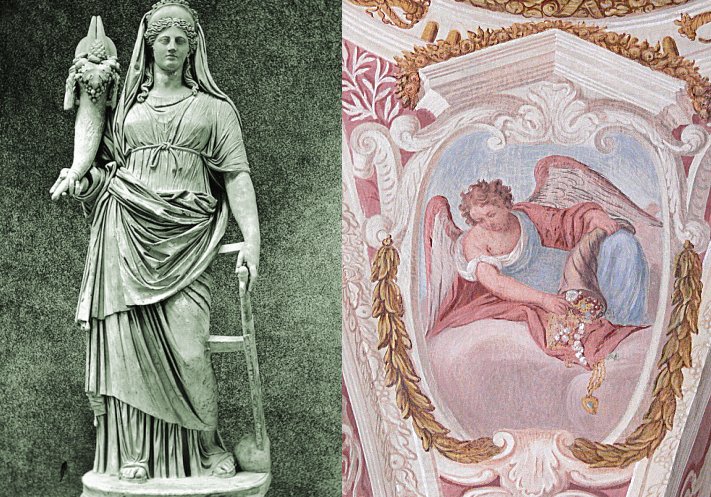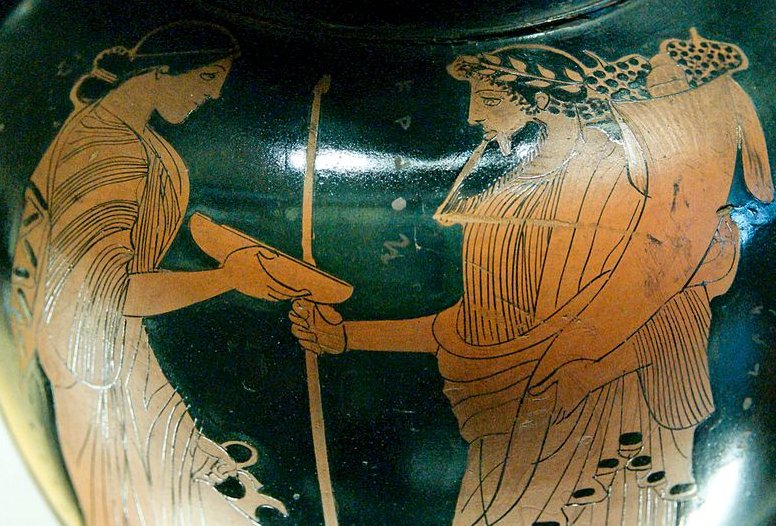Cornucopia – ‘Horn Of Plenty’ – Ancient Symbol And Its Almost Forgotten Meaning
A. Sutherland - AncientPages.com - A cornucopia (from Latin 'cornu copiae') - horn of plenty ) is often depicted in paintings and on friezes. It is a hollow horn-shaped container filled with abundant fruit, coins, flowers, grain, nuts, or any other desirable things.
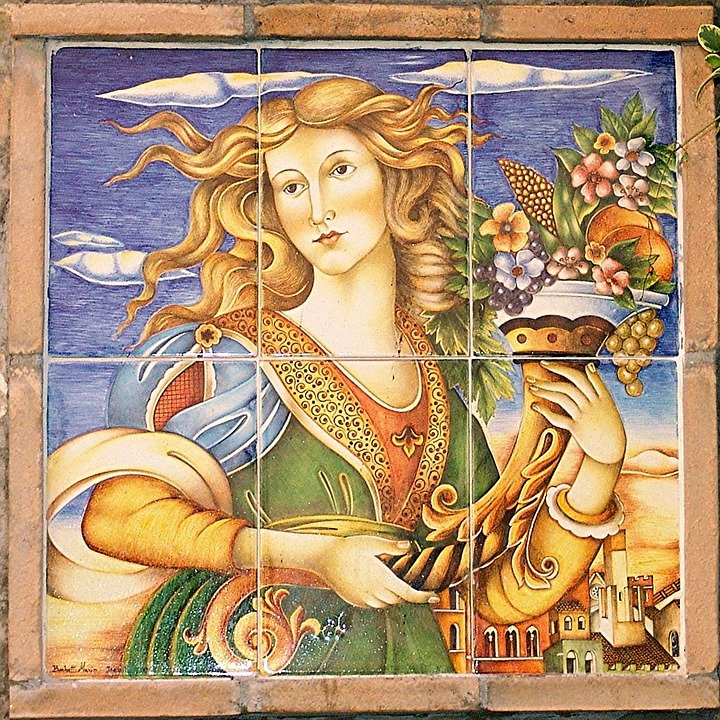 A woman holding a cornucopia. Public Domain
A woman holding a cornucopia. Public Domain
It is an ancient symbol of boundless abundance.
Many of us have a cornucopia at home; it can be made of plastic, wicker, metal, wood, or other materials. It can be symbolically filled with something valuable or simply beautiful.
Cornucopia – a horn of plenty – symbolizes wealth, abundance, fertility, and nourishment. It is highly respected by many ancient cultures, including the Celts, whose concept of abundance was central to their religion.
Initially, it represents a mythical symbol originating from the Mediterranean region of Europe. In North America, the cornucopia is associated with the country's great tradition of Thanksgiving, dating back to the Protestant Reformation in 16th-century Europe but the symbol of cornucopia dates back to very ancient times.
Popular Versions Of Cornucopia's Origin
Several mythological explanations suggest the origin of the cornucopia, some of which date back to the 5th century BC. Two of them are believed to be the most popular.
Left: Fortuna, the goddess of good luck, was given the power to bring prosperity to a human being and her attribute is a cornucopia - horn of plenty. Image credit: Vatican, Rome, Italy. Statue of Fortune. Brooklyn Museum; Right: Angel with the horn of plenty. Image credit: Wolfgang Sauber/Wikipedia
According to a version in Greek mythology, the cornucopia belonged to the goat Amalthea ("Nourishing Goddess"), who protected and raised the infant Zeus, who, even as a little boy, had enough strength to break off one of Amalthea's horns while playing. The horn then had the divine power to fill up with everything the owner wanted.
This mythological horn is known as the horn of plenty (cornucopia), and its tradition continues today.
In another myth, the cornucopia was created during one of Heracles' (Roman Hercules) missions to fight with the river god Achelous. During their encounter, Heracles broke off one of his horns.
Gods And Goddesses Were Often Depicted With Cornucopia
The cornucopia became the attribute of several Greek and Roman deities, particularly those associated with prosperity, harvest, or spiritual abundance.
Hades (right-hand side) with a cornucopia and Persephone (left-hand side). Detail from an Attic red-figure amphora, ca. 470 BC. Image credit: Jastrow - CC BY 3.0
Erecura (Aerecura), a goddess often considered Celtic in origin, was often depicted with attributes of fertility as the cornucopia and apple baskets. Also, Epona is associated with cornucopia, Dionysus, and Hades, the god of the underworld and ruler of the dead, who, as Plouton (or Pluto), is a bringer of agricultural, mineral, and spiritual wealth.
In ancient Roman religion, Abundantia was a divine personification of prosperity and abundance. She was often depicted with a cornucopia like the Roman goddess of peace, Pax, who cared for peace (Pax Romana) and wealth and had attributes like an olive branch and a horn of plenty.
Ancient sources confirm that the cornucopia or some versions were found on seals and buildings and imprinted in Jewish coins during the Maccabean times.
A Symbol Of Cornucopia In Ancient Egypt
The cornucopia was also an important symbol for ancient Egyptians.
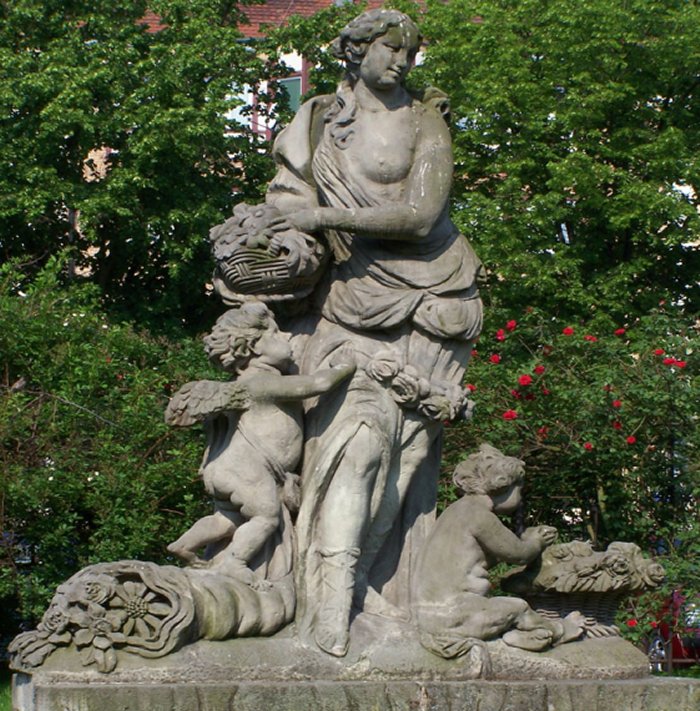 Cornucopia in the Statue of Flora in Szczecin, Poland. Image credit: Remigiusz Józefowicz - CC BY-SA 2.5 pl
Cornucopia in the Statue of Flora in Szczecin, Poland. Image credit: Remigiusz Józefowicz - CC BY-SA 2.5 pl
"Horus the Child (the Greek Harpocrates, the god of silence and confidentiality) was one of the best-loved. In the early centuries of the Christian era, he was depicted as a child, sometimes seated in a lotus blossom, a ship, or enthroned as a follower of the sun god. Frequently he carries a cornucopia or a jar…' Lewis Spence writes in his book 'Ancient Egyptian Myths and Legends.'
The legendary Cleopatra VII, the last active ruler of the Ptolemaic Kingdom of Egypt, struck several series of silver coins at the mint in Askalon. On one side of these coins, there is her portrait, and on the reverse (back), Ptolemaic coins have exceptionally only a few motifs; one of them is particularly popular (more than 95 percent) and shows a symbol of a cornucopia (on gold coins).
The cornucopia is still a popular decorative motif, although the symbol's very ancient sacred meaning has long been forgotten.
Written by – A. Sutherland - AncientPages.com Senior Staff Writer
Updated on April 3, 2023
Copyright © AncientPages.com All rights reserved. This material may not be published, broadcast, rewritten or redistributed in whole or part without the express written permission of AncientPages.com
Expand for referencesReferences:
Harrison J. E. Themis: A Study of the Social Origins of Greek Religion
Spence L. Ancient Egyptian Myths and Legends
More From Ancient Pages
-
 Skeleton Of Last Trojan Discovered – Ancient City Of Troy May Have Been A Religious Sanctuary – Archaeologists Say
Archaeology | Sep 21, 2018
Skeleton Of Last Trojan Discovered – Ancient City Of Troy May Have Been A Religious Sanctuary – Archaeologists Say
Archaeology | Sep 21, 2018 -
 Secrets Of Mysterious Bronze Age Hoard Found In Rosemarkie, Scotland Revealed
Archaeology | Jul 31, 2024
Secrets Of Mysterious Bronze Age Hoard Found In Rosemarkie, Scotland Revealed
Archaeology | Jul 31, 2024 -
 Mysterious Havering Hoard – Largest Ever Bronze Age Hoard Discovered In London
Archaeology | Oct 21, 2019
Mysterious Havering Hoard – Largest Ever Bronze Age Hoard Discovered In London
Archaeology | Oct 21, 2019 -
 Secret Ancient Knowledge Of Venus – Ancient Gods, Giants And More Controversial Theories – Part 2
Featured Stories | Jul 2, 2018
Secret Ancient Knowledge Of Venus – Ancient Gods, Giants And More Controversial Theories – Part 2
Featured Stories | Jul 2, 2018 -
 Mysterious Chachapoyas ‘Warriors Of The Clouds’ And Their Impressive Structures
Civilizations | Nov 4, 2020
Mysterious Chachapoyas ‘Warriors Of The Clouds’ And Their Impressive Structures
Civilizations | Nov 4, 2020 -
 Ancient Intriguing Sao People: “Men From Another Time” – One Of The Oldest Civilizations Of Central Africa
Featured Stories | Sep 28, 2015
Ancient Intriguing Sao People: “Men From Another Time” – One Of The Oldest Civilizations Of Central Africa
Featured Stories | Sep 28, 2015 -
 Did Queen Nitocris Build A Secret Underground Chamber To Commit Murder?
Featured Stories | May 23, 2024
Did Queen Nitocris Build A Secret Underground Chamber To Commit Murder?
Featured Stories | May 23, 2024 -
 Ancient Textile Mystery: King Canute Enshrined In His Own Clothes But Found In His Brother’s
Artifacts | Oct 5, 2020
Ancient Textile Mystery: King Canute Enshrined In His Own Clothes But Found In His Brother’s
Artifacts | Oct 5, 2020 -
 DNA Reveals 300,000 Years Of Hominin And Animal Presence At Denisova Cave
Archaeology | Jun 26, 2021
DNA Reveals 300,000 Years Of Hominin And Animal Presence At Denisova Cave
Archaeology | Jun 26, 2021 -
 Mysterious Ancient Tomb And A Strange Vanishing In France – DNA Failed To Solve The Riddle?
Featured Stories | Feb 20, 2024
Mysterious Ancient Tomb And A Strange Vanishing In France – DNA Failed To Solve The Riddle?
Featured Stories | Feb 20, 2024 -
 Antediluvian Sacred Tablets And Rare Manuscript Reveal Secret Ancient Egyptian Knowledge
Featured Stories | Apr 13, 2018
Antediluvian Sacred Tablets And Rare Manuscript Reveal Secret Ancient Egyptian Knowledge
Featured Stories | Apr 13, 2018 -
 On This Day In History: Seismologist Charles Richter Was Born – On Apr 26, 1900
News | Apr 26, 2016
On This Day In History: Seismologist Charles Richter Was Born – On Apr 26, 1900
News | Apr 26, 2016 -
 SPQR Was A Symbol Of The Roman Republic
Ancient History Facts | Dec 4, 2017
SPQR Was A Symbol Of The Roman Republic
Ancient History Facts | Dec 4, 2017 -
 Legend Of The Sun And Moon In Cherokee Beliefs
Featured Stories | Jul 9, 2019
Legend Of The Sun And Moon In Cherokee Beliefs
Featured Stories | Jul 9, 2019 -
 St. Simeon’s Monastery And History Of Its Founder Shed Light On Christian Past In Anatolia
Archaeology | Nov 28, 2020
St. Simeon’s Monastery And History Of Its Founder Shed Light On Christian Past In Anatolia
Archaeology | Nov 28, 2020 -
 TB Was Transmitted in South America – DNA Study Shows How It Happened
Archaeology | Mar 17, 2022
TB Was Transmitted in South America – DNA Study Shows How It Happened
Archaeology | Mar 17, 2022 -
 Surprising Discovery – Replica In The Field Museum Is A 3,000-Year-Old Sword
Artifacts | Jan 18, 2023
Surprising Discovery – Replica In The Field Museum Is A 3,000-Year-Old Sword
Artifacts | Jan 18, 2023 -
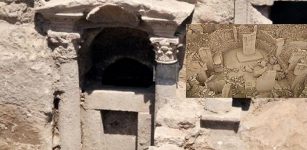 Kizilkoyun Necropolis: Excavations Of 2,000-Year-Old Rock Tombs Will Solve Mysterious Past Of Göbeklitepe
Archaeology | Sep 7, 2020
Kizilkoyun Necropolis: Excavations Of 2,000-Year-Old Rock Tombs Will Solve Mysterious Past Of Göbeklitepe
Archaeology | Sep 7, 2020 -
 More Than A Meteorite: New Clues About The Demise Of Dinosaurs
Paleontology | Dec 5, 2023
More Than A Meteorite: New Clues About The Demise Of Dinosaurs
Paleontology | Dec 5, 2023 -
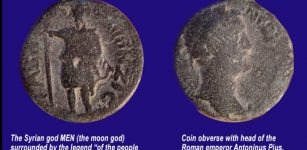 Unique 1800-Year-Old Roman Coin Unearthed On Southern Carmel
Artifacts | Mar 1, 2021
Unique 1800-Year-Old Roman Coin Unearthed On Southern Carmel
Artifacts | Mar 1, 2021

